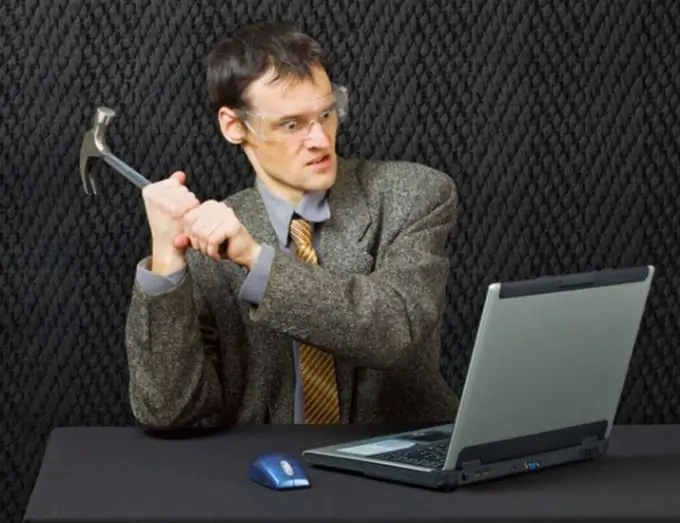Does your computer slow down, folders open for a long time, programs run hard, the system often hangs? Do not be nervous and do not rush to complain that the computer is hopelessly outdated. We will show you some tricks with which you can speed up your computer by 25-50 percent!

Instructions
Step 1
Let's make a Disk Cleanup. Cleaning the system from "garbage". We start the standard cleaning program.
For Windows 7: "Start -> All Programs -> Accessories -> System Tools -> Disk Cleanup" (right-click -> "Run as administrator").
For Windows XP: "Start -> All Programs -> Accessories -> System Tools -> Disk Cleanup"
If you have several hard disks installed on your computer (or one is split into several logical ones), then a window will appear asking which of these disks to clean up. Select the required system drive on which WINDOWS is installed. (Then it is better to carry out this procedure with all computer disks).
Check all the items suggested in the box, click "OK" - and wait. You may have to wait a long time, depending on the "trash" of the system
Step 2
Now let's check the hard disk of the computer for errors and failures. Close all running programs first and remove all external media (flash drives, hard drives, etc.). For Windows XP and Windows 7, the procedure is the same.
Open the "My Computer" window in the "explorer". Right-clicking on the system disk or partition of this disk, select "Properties". In the window that opens, go to the "Service" tab, and there click on the "Check" button. A small window will open in which you need to tick the 2 check points presented and press the "Start" button.
A message will appear stating that Windows cannot check the disk that is currently in use and will offer to do this after reboot. Click Schedule Check Disk for Windows 7 and Yes for Windows XP. Reboot your computer. After reboot, the scheduled disk check will begin in text mode. Until it completes, the operating system will not start. The check will most likely take a long time, so it will be more expedient to run it at a time when the computer is not required (for example, leave it to check overnight).
Step 3
The next step will be to defragment the system disk. We launch the standard disk defragmentation program.
For Windows 7: "Start -> All Programs -> Accessories -> System Tools -> Disk Defragmenter" (right-click -> "Run as administrator").
For Windows XP: "Start -> All Programs -> Accessories -> System Tools -> Disk Defragmenter"
In the window that opens, select the disk on which the operating system is installed and click on the "Disk Defragmenter" button. (Then it is better to carry out this procedure with all computer disks).
Step 4
Now we will "pozhamanim" with the size of the swap file.
For Windows XP: "Right click on My Computer -> Properties -> Advanced -> Performance -> Options -> Advanced -> Virtual Memory -> Change".
For Windows 7: "Right click on" Computer "-> Properties -> Advanced settings -> Performance -> Settings -> Advanced -> Virtual memory -> Change.
In the window that opens, select "Specify size" ("Custom size" for XP)
Now we multiply the entire amount of your RAM by 1, 5 (if it is very small, then by 2). The resulting value is written in the fields "Original size", and "Maximum size"
(And as an exception, if the computer has 4 gigabytes of RAM and Windows XP is installed, then you can set a small value, for example, 512 megabytes)
Step 5
Disable unused services. "Start -> Control Panel -> Administrative Tools -> Services". In this large list of all services, we study the names and descriptions of all services. We decide that all of this can be turned off without affecting the state of the system.(Specific advice on the advisability of disabling a particular service can be easily found on the Internet). We stop the selected services (double-click on the selected service "Startup type -> Disabled" and click on the "Stop" button)
Step 6
Disable unused startup items. First, go to "Start -> All Programs -> Startup" and remove all unused shortcuts from there. Then run the standard system startup configuration program: "Start -> Run" and write "msconfig" in the line, go to the "Startup" tab and disable all unused programs. (You can easily find specific advice on the advisability of disabling a particular program in startup on the Internet by typing the name of the program in a search engine)
Step 7
Disable visual effects.
For Windows XP: "Right click on My Computer -> Properties -> Advanced -> Performance -> Options -> Visual Effects".
For Windows 7: "Right-click on" Computer "-> Properties -> Advanced settings -> Performance -> Settings -> Visual effects".
In the window that opens, switch the item "Provide best performance" -> OK
Step 8
Disable unused devices.
For Windows XP: "Right click on My Computer -> Properties -> Hardware -> Device Manager".
For Windows 7: "Start -> Control Panel -> Hardware and Sound -> Device Manager"
In the window that opens, disable unused devices (right-click on the selected item -> "Disable")
You can disconnect unused camera, network card, IEEE 1394 controller, COM and LPT ports, etc. In which case, the disabled device can always be "activated" if needed
Step 9
We clean the computer from viruses with an antivirus with up-to-date antivirus databases. You can use both permanently installed anti-virus programs and free "one-time" programs for current scanning, such as CureIT from Dr. Web,






